A Sunstone Odyssey, Part 2:
The Dust Devil
Duncan Pay, Robert Weldon, and Kevin Schumacher
October 20, 2013
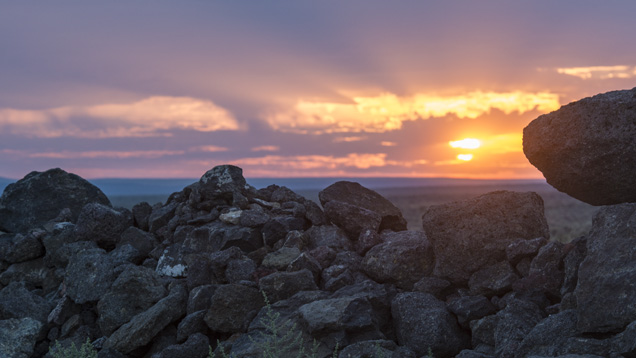
The setting sun casts orange rays above basalt boulders at the edge of the Dust Devil mine in southeast Oregon’s high desert. The mine is one of the region’s more important commercial sunstone sources. Photo by Robert Weldon.
INTO THE VALLEY
For the last couple of days we’ve been surrounded by the Ponderosa mine’s towering pines. Today, we’re a hundred miles farther south—and a thousand feet lower—on the road to the Plush sunstone mining area. Our next stop is Don Buford and Terry Clarke’s Dust Devil Mine in the heart of the Rabbit Basin. This is expansive country: forbidding volcanic hills form steep ridges that loom above flat, open valleys dotted with sagebrush. The high desert has its own unique beauty.
Take a journey to Oregon’s Dust Devil mine. Set in the state’s remote southeast corner, the location produces some fabulous large sunstones, many of which have been carved into award winning gems.
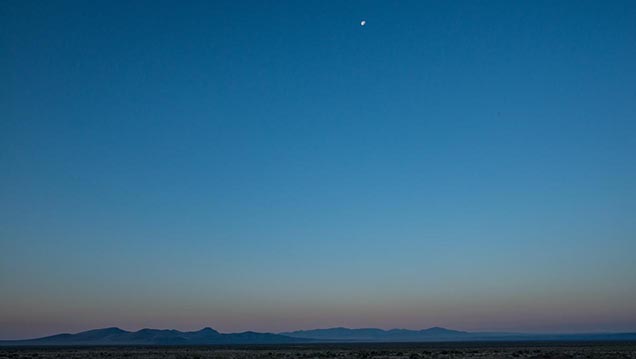
We make the turn off Highway 395’s smooth pavement and head east on Hogback Road’s gravel surface. “Call from there to let us know you are on Hogback Road,” Don’s email said. Everyone has the same cell-phone carrier—there’s no signal, so we can’t oblige.
Don’s email also told us that any car with decent tires would do, and after thirty bumpy miles, we arrive at the mine. As Don assured us: “You can’t miss us, lots of trailers and shakers and conveyors.”
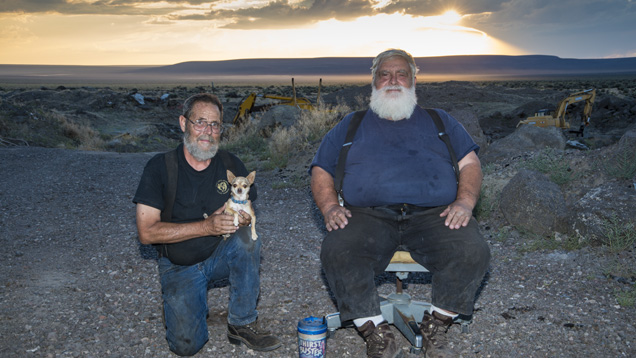
Terry Clarke and Don Buford have been mining sunstone in the Oregon desert for 21 years. Photo by Robert Weldon.
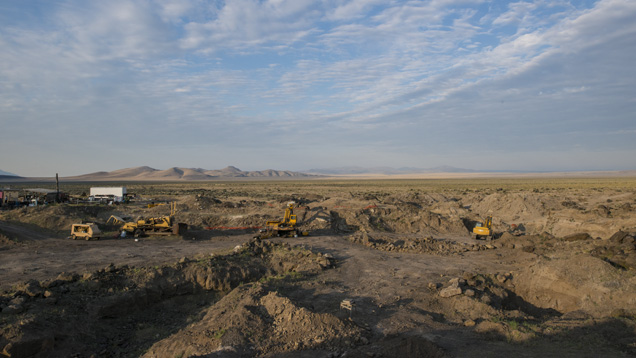
This view of the Dust Devil Mine shows Dudeck Ridge in the background. This is likely the local source of the sunstone-bearing lavas. Photo by Robert Weldon.
We ask Don about the history of sunstone in the area known by the miners as the “valley.” He tells us, “Native Americans traded sunstones as far as British Columbia, the Mississippi Delta…and they’ve been found in Viking burial grounds in the northeast.”
Don mentions that Tiffany & Co. of New York mined clear feldspar here as a diamond substitute as recently as the 1950s. Their endeavors led to the gems’ local name: “Plush diamonds.” He adds that they only mined close to the surface and “didn’t get deep enough to get the really nice colored stones.”
MASTERS OF MECHANICAL IMPROVISATION
We ask how Dust Devil got its start, and Don tells us it began as an Explorer Post for the Boy Scouts of America. “We were just looking for something for our scouts to do,” he continues. “We came down here to find some mining claims, and once I started digging, I was very fascinated with the beauty of the stones and how totally different they are from anything else.”
That was the catalyst. Terry and Don started digging for sunstones on weekends and vacations. “We started off with shovels, sixteen-pound sledgehammers, and hand screens, and eventually bought an ancient backhoe.”
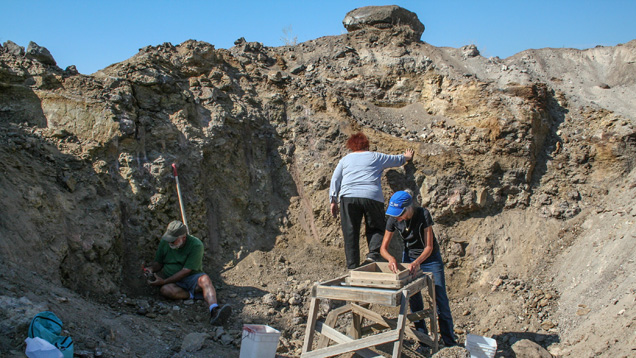
The pit is worked the old-fashioned way. In this image, fee-paying diggers are using screens and shovels to mine the basalt. They only pay for the material they want to keep. Photo by Duncan Pay.
From there on, they obtained any used parts and any scrap steel they could find, and built it into mining machines. “Our first machine was an old school bus that we made into a flatbed.” He adds, “We’ve been out here 21 years, and we’ve seen sunstone go from a stone that nobody had any idea what it was, to now being on the threshold of being an important international stone.”
(video)
The Dust Devil's Origins
Mine owner Don Buford outlines the mine’s history and explains its origin as a Boy Scout Explorer Post.
THE MINING PROCESS
Don explains that the mine’s location is very favorable. “We’re on the edge of what was a great inland sea, and a river flowed right past our camp, so we have a lot of decomposition of the basalt that holds the sunstone.” This makes the rocks that contain the gems softer and easier to mine.
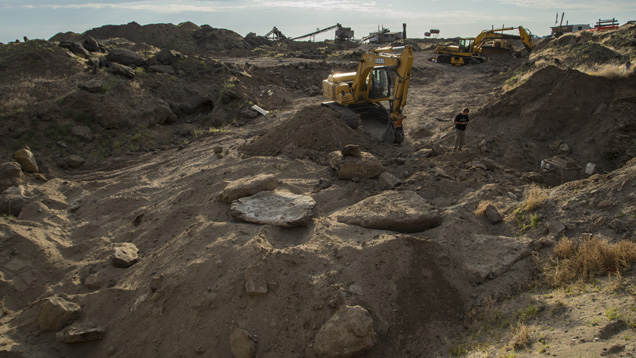
This view shows the Dust Devil pit with the mine’s processing plant in the background. Photo by Robert Weldon.
Dust Devil miners use backhoes to work the pit and big loaders to transport the ore to a processing plant. There’s a “grizzly”—mining parlance for a grille that keeps bigger boulders out of the processing plant—and conveyor belts that lead to a shaker and a trommel.
The shaker removes material that’s less than two inches and more than five-sixteenths of an inch in size, Don explains. The trommel washes the concentrate, which then goes to either a one-cubic-yard hopper, where people can pick it off a belt, or to a sophisticated optical sorting machine.
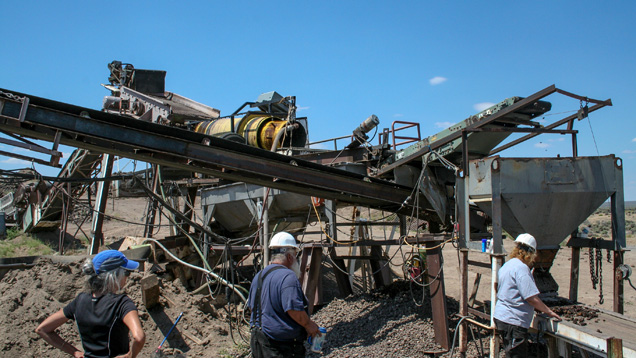
In this view of the mine’s processing plant, the shaker at top left is feeding ore into the yellow cylindrical trommel. Concentrate can either be directed to the hopper and belt in the foreground or to the optical sorting machine via the conveyor running diagonally to the left. Photo by Duncan Pay.
During our visit, an electrical fault prevented us from documenting the optical sorter. We hope to return at a later date to see the machine in action.
(video)
Mining the Dust Devil
Don Buford explains the advantages of the mine’s location and how the miners separate the gems from the surrounding ore.
DESERT WISDOM: SHARP-EDGED STONES, TALL SAGEBRUSH, AND BIG ANTHILLS
After a lifetime of working the desert for sunstone, Don turns his miner’s eye to the landscape for clues. The first things he looks for on the surface are stones with sharp edges, which indicate they’ve been recently deposited and there’s probably more underground. He tells us that worn stones with sand-blasted edges might have come from some distance away, or might even have been on the surface for 100,000 years.
Next, he seeks out the tallest sagebrush because it can indicate easier mining conditions. Much of the rock covering the sunstone-bearing basalt is heavy, requiring drilling and blasting, but tall sagebrush—above five or six feet—is a good indication that the plant’s roots are able to reach water, and that means, as Don explains, “the rock is fractured…we can get through it.”
Finally, he advises not to forget the ants. The desert supports vast populations of them. Don indicates that they require a little respect: “These are red ants that have a really nasty bite.”
Around a big ants’ nest, he says, they’ll completely clear a circle ten feet in diameter, then use little pebbles and sunstones to build their mound. They even arrange them close together so when it rains, the water runs off. There’s another benefit: sunstones reflect the light, so in the summer they help regulate the anthill’s heat.
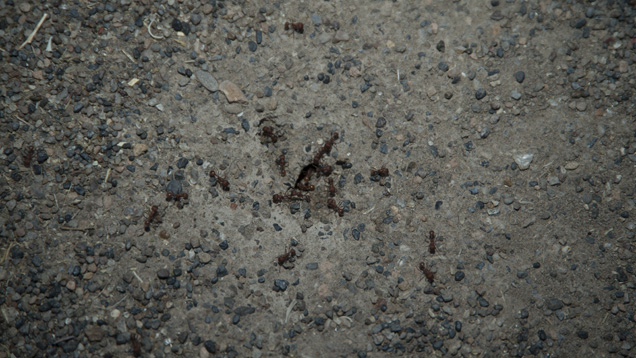
People aren’t the only ones to mine the desert for gems. Ants collect tiny fragments of feldspar around their nests. Photo by Robert Weldon.
Just like tall sagebrush, a bigger anthill indicates possible penetration into the ground. It’s a strong signal that the rocks underneath are weathered and easier to mine. All these clues tell miners that it’s a good idea to dig adjacent to the anthills.
(video)
Prospecting for Sunstone
Miner Don Buford shares some of the desert-prospecting wisdom he’s acquired over the years.
ENVIRONMENTAL CONSTRAINTS AND CHALLENGES
Unlike the Ponderosa, which has several natural springs on the property, there’s absolutely no water at the Dust Devil Mine. The Bureau of Land Management (BLM)—the federal agency that administers public lands—prohibits any kind of permanent development in the Rabbit Basin and insists the land be restored to its pre-mining state.
Don explains the location’s challenges: “We’re 21 miles from the nearest electrical power, so we make our own power…We haul our drinking water in from 30 miles away. Our mining water comes from a well that’s six miles away.”
All the water used in mining is extensively recycled. A series of six holding tanks recirculates the 10,000 gallons of water used for washing the concentrate. They allow progressively finer material to separate out before the water is used again. As Don says, “This is the desert, and water is hard to come by…so we don’t use more than we have to.”
When mining ceases, the miners will have to re-contour and replant the area with native species. On his own initiative, Don is planting the native bunch grasses that grew in the valley before extensive sheep farming eradicated them. “We’re putting it back to the way it was before the white man came here and had an effect on the land,” he says.
The desert is hard on men and machines. The gritty attrition of dust and the ringing impact of metal on rock take their toll. You have to be tough and mechanically minded to make it here. “We’re pretty self-sufficient,” he says. “We have a lot of equipment. It’s old equipment and it breaks down a lot, but we have the tools and technology to repair almost anything.”
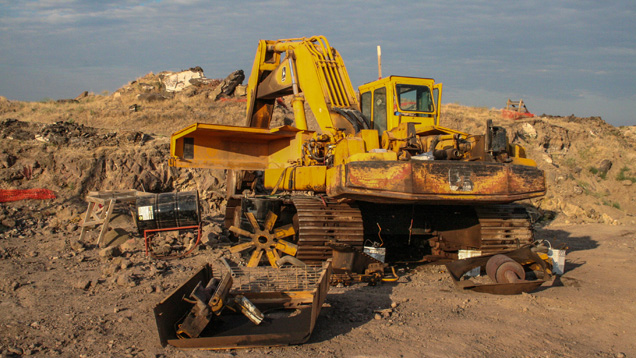
When we asked mine employee Mark Shore what it might take to fix this backhoe, he replied “about five sticks” (of dynamite!). Photo by Duncan Pay.
This led us to question the cost of mining in such a challenging environment. With a wry smile, Don admits: “We actually pay every month for the privilege of coming out here and digging these beautiful stones…and getting to hang out with some of the best people in the world.”
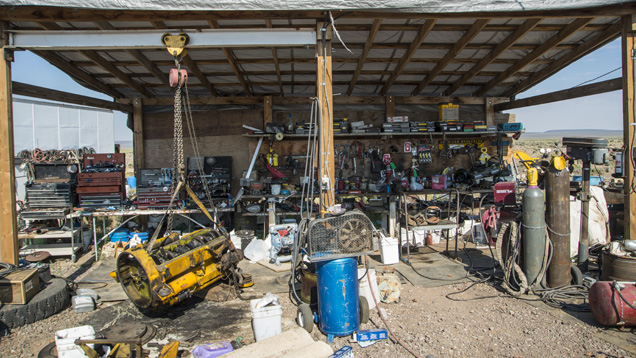
The mine’s harsh, dusty desert environment and its distance from service centers require a fully-equipped machine shop to keep heavy equipment running at Dust Devil. Photo by Robert Weldon.
The act of mining—of recovering beautiful sunstone—outweighs the simple financial rewards for Don and Terry. We get the sense that their best possible legacy for half a lifetime of work would be widespread recognition of Oregon sunstone as a mainstream gem.
Don’s next answer reinforces the fact that he has already done more than anyone to raise this gem’s profile among jewelry designers: “When we got into the very, very large stones in this pit, which at that time were the largest that anyone had ever found, we took our best material to the Tucson International Gem Show.”
He explains how they met with artists that they enjoyed working with and gave them the stones so they could carve or cut them and enter them into prestigious competitions run by the American Gem Trade Association (AGTA). “Over the years,” he continues, “we’ve won sixteen Cutting Edge awards with our stones. We try to be real humble about it, but several of those artists have said that a lot of their fame has come from cutting our stones. Had we not given them those stones, they wouldn’t be where they are today.”
(video)
Challenges of Desert Mining
Don Buford outlines many of the challenges of operating in a harsh desert environment.
BEAUTIFUL SUNSTONE
For Don, red gems with the glitter of native copper are the most fascinating: “I like the red stones with the copper schiller bars running through them.” Although bicolor gems and stones displaying red to green dichroism might be more rare, he prizes these gems the most. “The reds with the schiller are just very, very dynamic, and there’s nothing else in the world that looks like it.”
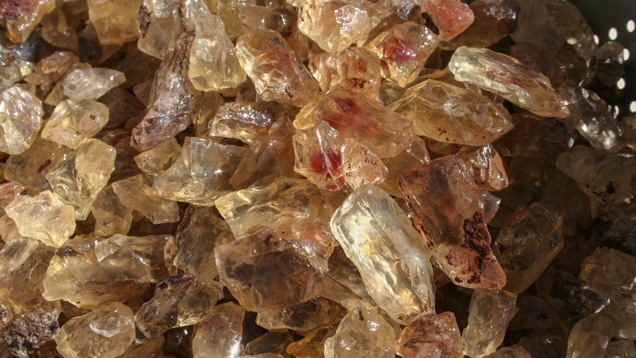
This is what it’s all about: Kilos of gem-quality rough remain after a Dust Devil production run. Photo by Duncan Pay.
Just like John Woodmark of the Ponderosa, Don emphasizes the individual nature of this product. “Every stone is unique, like opal.” He acknowledges that “matching stones up is very difficult.” However, there’s a benefit to this downside, as consumers seek gems that help convey their own individuality: “We’ve always believed that no two women want to look exactly alike.”
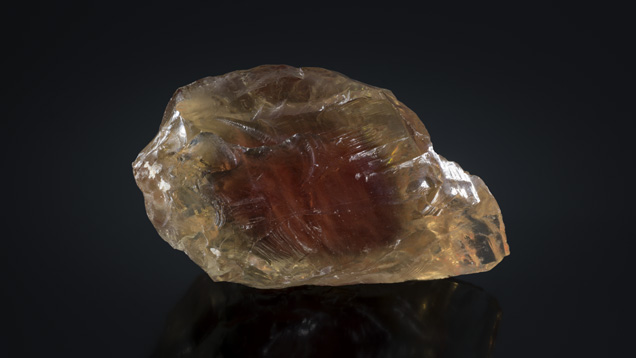
This 101.63-ct. rough sunstone has a deep red core with schiller. It’s likely to be fashioned into a fabulous carving. Photo by Robert Weldon.
Don’s next statement encapsulates his view of Oregon sunstone’s place in the international jewelry marketplace: “Sunstone should be in ... "[/i]
https://www.gia.edu/gia-news-research-d ... nstone-pay
